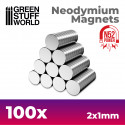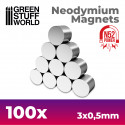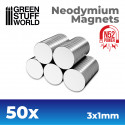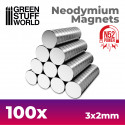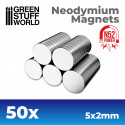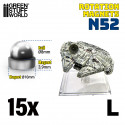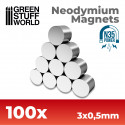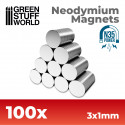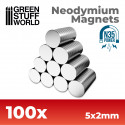What is the strongest magnet?

Magnetism is an invisible force present in all types of magnets, from the simplest ones that stick to the refrigerator to the most sophisticated medical equipment, like MRI machines. Throughout history, humanity has worked on various projects to improve magnets, driving technological advancement. But, currently, what is the strongest magnet of all?
The answer is not as simple as it seems, as it depends on whether we are talking about commercially available magnets or the supermagnets created in scientific laboratories for research purposes.
Below, we explain everything you need to know to understand why a magnet is the most powerful and what characteristics it must have. The basis of everything is magnetism, one of the four fundamental forces of nature and a manifestation of the electromagnetic force.
What is a Magnet?
A magnet is an object with the capacity to generate a magnetic field around it. This field is responsible for the force of attraction or repulsion experienced by other magnetic materials or magnets.
The key to a magnetized piece lies in the movement of its electrons. In all materials, electrons are constantly moving around the atom's nucleus (orbits) and rotating on their own axis (spin). These movements of electric charge generate small magnetic fields at the atomic level. Think of each electron as a tiny magnet.
In non-magnetic materials (like wood or plastic), these small internal magnetic fields are randomly oriented and cancel each other out, making the material neutral, i.e., non-magnetic.
In magnetic materials (ferromagnetic materials, such as iron, nickel, and cobalt), the atomic structure allows large groups of these atomic fields, called magnetic domains, to align in the same direction. When most of these domains are uniformly oriented, the material becomes a magnet. This alignment process, called magnetization, requires exposing the material to a strong external magnetic field.
Magnetic Poles
Every magnetized piece has two well-defined ends called poles: the North Pole (N) and the South Pole (S). The magnetic force is most intense at these poles. A fundamental rule of magnetism, widely known as a popular saying, is:
• Opposite poles attract: North attracts South (N →← S).
• Like poles repel: North repels North (N ←→ N) and South repels South (S ←→ S).
This is the same principle underlying the compass, whose magnetic north pole is attracted by the Earth's magnetic south pole (located near the geographic North Pole). It is impossible to isolate a single pole; if you cut a magnetized piece in half, each half instantly develops a new pair of poles. For this reason, magnetic monopoles are said not to exist.
Differences Between a Magnet and a Magnetic Field
Understanding this distinction is essential for understanding the physics behind the strongest magnet.
• The Magnet (the cause). It is the physical object, the material (a ferrite bar, a neodymium disc) that acts as the source creating the magnetism. It is an object measurable by its mass (amount of matter), shape, and composition (what the matter is made of).
• The Magnetic Field (the effect and the measurement). It is the invisible zone of influence surrounding the magnetized piece. It is the way the magnetic force manifests in space. The magnetic field is represented by flux lines that exit the North Pole and enter the South Pole. It is through this field that the magnetized piece exerts force at a distance on other objects.

To measure the power of the strongest magnet, we measure the intensity of its magnetic field in teslas (T). One tesla is the International System unit for magnetic flux density. To put it in perspective:
• Earth's magnetic field: ≈ 0.00005 T
• Common refrigerator magnetized piece: ≈ 0.001 T
• Hospital MRI machine: ≈ 1.5 T to 3 T
Types of Magnets
The strength, cost, and use of magnets depend on their composition. There are three main categories that lead us directly to identify the strongest magnet.
1. Permanent ones. (Constant Force). They retain their magnetism almost indefinitely. The strongest permanent magnets that are commercially available are rare-earth ones. The two types of rare-earths are neodymium magnets and samarium-cobalt:
• Neodymium (NdFeB): They are composed of neodymium, iron, and boron. They are, by far, the strongest permanent magnets commercially available. Their strength is astonishing in relation to their size (high Maximum Energy Product, measured in MegaGauss Oersted, MGOe). They are classified by grades (N35 to N52), where N52 is the most powerful and the current standard for the strongest magnet you can buy. Both models are available at Green Stuff World for crafts and inclusion in miniatures.

• Samarium-Cobalt (SmCo): Less powerful than neodymium at room temperature, but with superior temperature resistance (up to ≈ 350ºC). They are crucial in aerospace and military applications where heat is a limiting factor.
2. Temporary ones (Induced Magnetism). These are materials that exhibit magnetism only when in the presence of a strong external magnetic field (like a permanent ones or an electromagnet). Unlike permanent ones, they lose most of their magnetism quickly when the external field disappears. A clear example is the iron nail or paper clip. These adhere strongly to a magnetized piece, but if separated, they do not retain the ability to attract other objects by themselves.
3. Electromagnets (Controlled and Extreme Force). An electromagnet generates a magnetic field from an electric current flowing through a coil of wire.
• Advantage: Its strength can be easily controlled by varying the current and can be activated or deactivated.
• Power: When powered by massive currents, they can generate magnetic fields that far surpass any permanent type. The absolute strongest magnet in the world is a type of electromagnet.
So, what is the strongest magnet?
As we have already mentioned, the answer to this question has two dimensions: the commercial champion and the absolute champion.
1. The Strongest Commercial magnets
In the first place of the strongest commercial magnet ranking is the neodymium magnet. Specifically, the N52 neodymium , the strongest grade that exists, as it offers the highest magnetic flux density. A small neodymium cube of this grade can lift thousands of times its own weight. Its power is due to the crystalline structure of neodymium, which has high magnetic anisotropy, meaning it possesses a very strong and stable preferred direction for its magnetism, as well as great resistance to demagnetizing its magnetic domains.
This allows for immense magnetization. However, due to this intense force, large neodymium magnetized pieces must be handled with extreme caution. If two magnets of a certain size collide, they can break, launching fragments at high speed or crushing fingers or other body parts with enough pressure to cause serious injuries.
2. The Strongest Magnet in the Scientific Field
The industrial, and actually absolute, champion in terms of magnetic field intensity is a magnet known as the Superconducting Hybrid Electromagnet. It is located at the National High Magnetic Field Laboratory (MagLab) in Florida, USA.
• Sustained Record: It achieved a constant magnetic field intensity of 45 Teslas. It combines an external solenoid of superconducting material, which generates the background magnetic field, with an internal copper coil that receives a large amount of energy to generate the extreme magnetic field.
• Pulsed Record: At the Los Alamos National Laboratory (LANL), "non-destructive" magnetic fields of up to 100 Teslas have been reached, and in destructive experiments, even greater fields (hundreds of Teslas), but these only last fractions of a second.
45 Teslas is the most intense sustained magnetic field created by man and is about a million times stronger than the Earth's field, consolidating it as the strongest magnet known continuously. But, of course, this type it is not available for commercial purposes, so, for personal use, the strongest magnet you can find is the neodymium.
What is neodymium?
Neodymium is a chemical element with the symbol Nd and atomic number 60. It belongs to the lanthanide series and is classified as a rare earth metal, though it is more common in the Earth’s crust than the term suggests. It was first identified in the late 19th century through the separation of an earlier substance known as didymium. Despite its relatively high natural abundance, neodymium is never found in pure metallic form but is always bound within mineral compounds.
Geologically, neodymium is found within rare earth minerals such as monazite and bastnäsite, where it is mixed with several other lanthanide elements. Extracting neodymium involves a complex refining process that includes crushing the mineral, chemical treatment, and advanced separation techniques such as ion exchange or solvent extraction to isolate the metal in usable form. As global demand for advanced technologies increases, so does the importance of neodymium extraction and processing.
One of its most valuable uses is in the production of high-strength permanent magnets, especially when alloyed with iron and boron. These magnets are critical in many modern technologies, including electric vehicle motors, wind turbine generators, hard drives, headphones, and high-performance audio systems. Neodymium is also used in the field of optics and lasers, particularly in devices that require precise light emission, such as medical lasers or scientific instruments.
Although neodymium is more abundant than some base metals, its distribution is uneven, and processing it is challenging, which gives it strategic importance. The majority of global production is concentrated in a few countries, with China being the leading supplier. This makes neodymium not only a technologically vital element but also a key factor in discussions on material security and sustainable industrial development.
Neodymium Magnets at Green Stuff World
In Green Stuff World's online modeling store, we have a vast variety of neodymium magnets for crafts and modeling. The diameter of our N52 and N53 magnets varies between 8 and 2 millimeters. The thickness can also differ between 0.5 and 2.5 millimeters. Furthermore, this category includes rotation magnets for displaying spaceships, adding details to a diorama, or any other use you can think of in any other project.
Finally, we also have RC body magnets that facilitate placing and separating the body shell of the car, which is very necessary in this discipline for carrying out pertinent repairs after each race. Thanks to the great magnetic force of this material, screwing the body shell, as was done in the past, is no longer necessary, which made the process much more tedious.

Therefore, if you want to get the strongest magnet of the best quality on the market, don't forget to take a look at the GSW catalog, where you will also find many more materials for crafts and dioramas, from acrylic paints to glue, including all types of putties and resin bits.
Share this content
 Cookie preferences
Cookie preferences







